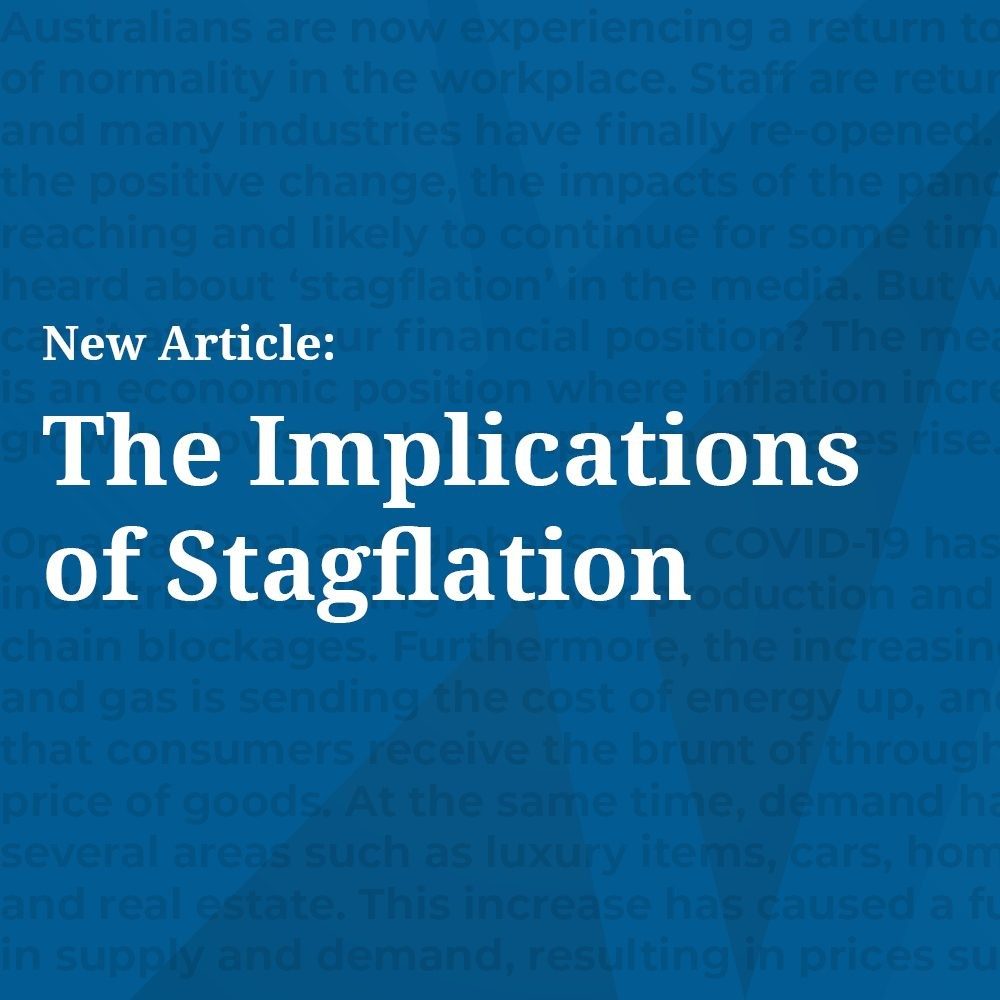Australians are now experiencing a return to some semblance of normality in the workplace. Staff are returning to the office, and many
industries have finally re-opened. Although, despite the positive change, the impacts of the pandemic are far-reaching and likely to
continue for some time. We have recently heard about 'stagflation' in the media. But what is it? And how can it affect your
financial position?
 The meaning of stagflation is an economic position where inflation increases but economic growth slows, and unemployment rates rise. On a
national and global scale, COVID-19 has impacted many industries resulting in lower production and significant supply chain blockages.
Furthermore, the increasing price of oil, coal and gas is sending the cost of energy up, and it's a said cost that consumers receive
the brunt of through the increased price of goods.
The meaning of stagflation is an economic position where inflation increases but economic growth slows, and unemployment rates rise. On a
national and global scale, COVID-19 has impacted many industries resulting in lower production and significant supply chain blockages.
Furthermore, the increasing price of oil, coal and gas is sending the cost of energy up, and it's a said cost that consumers receive
the brunt of through the increased price of goods.
At the same time, demand has increased in several areas such as luxury items, cars, home improvement and real estate. This increase has
caused a further imbalance in supply and demand, resulting in prices surging for many goods and services, particularly as we head into the
end of the financial year.
"alongside this inflation, we are not seeing wages increase; unemployment is rising, and economic growth has slowed."
 And
yet, alongside this inflation, we are not seeing wages increase; unemployment is rising, and economic growth has slowed.
And
yet, alongside this inflation, we are not seeing wages increase; unemployment is rising, and economic growth has slowed.
However, while this position may seem alarming at face value, most economists believe we will not return to the dire stagflation levels
seen in the 1970s global financial crisis. Policymakers learned from experiences during that time, and industries are different now due to
technology and the saving grace of our strong economy before COVID-19. Moreover, we know the cause of this imbalance and stagflation lies
in the specific trigger event in the COVID-19 pandemic.
"leading economists believe we will not return to the dire stagflation levels seen in the 1970s global financial crisis."
As the world slowly returns to normal and the disruptions to supply chains ease, inflation is likely to return to pre-pandemic levels
gradually, and the economy will likely begin to mend itself.


 The meaning of stagflation is an economic position where inflation increases but economic growth slows, and unemployment rates rise. On a
national and global scale, COVID-19 has impacted many industries resulting in lower production and significant supply chain blockages.
Furthermore, the increasing price of oil, coal and gas is sending the cost of energy up, and it's a said cost that consumers receive
the brunt of through the increased price of goods.
The meaning of stagflation is an economic position where inflation increases but economic growth slows, and unemployment rates rise. On a
national and global scale, COVID-19 has impacted many industries resulting in lower production and significant supply chain blockages.
Furthermore, the increasing price of oil, coal and gas is sending the cost of energy up, and it's a said cost that consumers receive
the brunt of through the increased price of goods.
 And
yet, alongside this inflation, we are not seeing wages increase; unemployment is rising, and economic growth has slowed.
And
yet, alongside this inflation, we are not seeing wages increase; unemployment is rising, and economic growth has slowed.